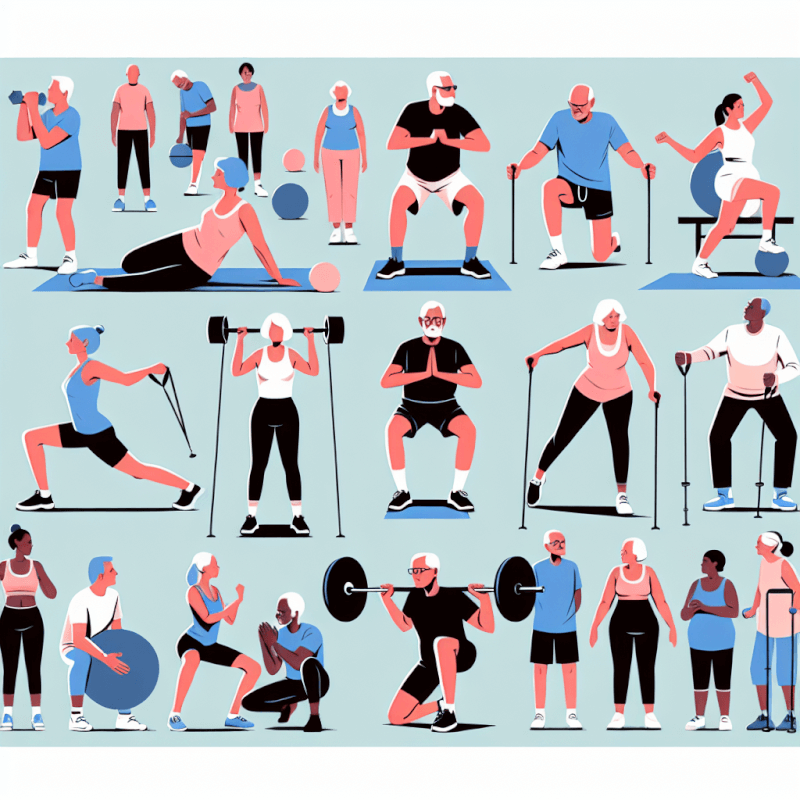As you age, staying active and maintaining muscle strength becomes increasingly important. That’s where resistance training comes in. This type of exercise, which involves moving your muscles against resistance, offers a multitude of benefits for older adults. From improving bone density and muscle mass to enhancing balance and reducing the risk of falls, resistance training can keep you fit, healthy, and independent as you grow older. In this article, we will explore the various advantages that resistance training brings to older adults, empowering you to make informed decisions about your fitness routine. Resistance training, also known as strength training or weightlifting, offers a multitude of benefits for older adults. Whether you’re a retiree looking to maintain your independence or simply aiming to live a healthier lifestyle in your golden years, incorporating resistance training into your exercise routine can have profound positive effects on your overall well-being. Let’s explore the numerous advantages that resistance training can provide for older adults.
Improves muscle strength and function
One of the primary benefits of resistance training for older adults is the improvement in muscle strength and function. As we age, our muscles naturally start to lose mass and strength, which can result in decreased mobility and limitations in performing daily activities. However, engaging in regular resistance training can combat these effects by increasing muscle mass and enhancing overall muscle strength.
By incorporating exercises that target various muscle groups, such as squats, lunges, and bicep curls, you can effectively build and maintain your muscle strength. This, in turn, allows you to perform everyday tasks with ease and reduces the risk of muscle-related injuries.
Increases muscle mass
Not only does resistance training improve muscle strength, but it also increases muscle mass. This becomes especially crucial for older adults, as muscle mass tends to naturally decline with age. By engaging in resistance training, you can counteract this decline and build new muscle tissue, resulting in a more toned and defined physique.
Having a higher muscle mass also offers practical benefits, such as increased metabolism and improved balance. Additionally, greater muscle mass can enhance your physical appearance and boost your self-esteem, promoting a positive body image and overall well-being.
Enhances muscle strength
In addition to increasing muscle mass, resistance training also enhances muscle strength. This is particularly important for older adults as it can improve their ability to perform daily tasks and maintain their independence.
By regularly engaging in strength-focused exercises like bench presses, leg presses, and shoulder presses, you can strengthen the major muscle groups in your body. This can translate into improved functional capacity, allowing you to lift heavier objects, climb stairs effortlessly, and perform other physical activities with ease.
Improves muscle power
Another advantage of resistance training is the improvement in muscle power. While muscle strength refers to the ability to exert force, muscle power encompasses the speed at which force is generated. Having good muscle power is essential for quick movements, such as getting up from a chair or avoiding a fall.
By including explosive exercises like box jumps, medicine ball throws, and power cleans in your resistance training routine, you can specifically target and enhance your muscle power. This can greatly enhance your ability to respond quickly to unexpected situations and maintain your stability and balance.
Enhances muscle endurance
Resistance training not only improves muscle strength and power but also enhances muscle endurance. Having good muscle endurance means being able to sustain a muscle contraction for an extended period, leading to increased stamina and reduced fatigue during physical activities.
By incorporating exercises with higher repetitions and lighter weights, such as push-ups, squats, and planks, you can effectively improve your muscle endurance. This can be particularly beneficial for activities that require prolonged physical exertion, like gardening, hiking, or playing with grandchildren.

Improves bone density and reduces the risk of osteoporosis
As we age, the risk of developing osteoporosis and experiencing bone fractures increases. However, resistance training can significantly mitigate these risks by improving bone density and reducing the likelihood of fractures.
By subjecting your bones to controlled stress during resistance exercises, such as weightlifting or using resistance bands, you stimulate the bone remodeling process. This, in turn, leads to an increase in bone mineral density, making your bones stronger and more resistant to fractures.
Increases bone mineral density
Resistance training plays a vital role in increasing bone mineral density, ultimately promoting healthier bones. By applying stress to your bones through weight-bearing exercises, such as squats, lunges, and deadlifts, you stimulate the production of new bone tissue.
This increase in bone density is particularly beneficial for older adults, as it reduces the risk of developing osteoporosis and minimizes the severity of fractures. Keeping your bones strong and healthy is crucial for maintaining optimal mobility and reducing the risk of bone-related injuries.
Reduces the risk of fractures
By improving bone density, resistance training also contributes to a reduced risk of fractures. Fractures, especially those resulting from falls, are a significant concern for older adults, as they can lead to a loss of independence and a decline in overall quality of life.
Through regular resistance training, you can strengthen your bones and improve their ability to withstand impact. This reduces the risk of fractures and allows you to maintain an active lifestyle with confidence, lowering the fear of falls and associated injuries.
Improves balance and reduces the risk of falls
In addition to enhancing bone density and reducing fracture risk, resistance training also improves balance, helping to reduce the likelihood of falls. Falls are a common concern among older adults and can result in severe injuries and prolonged recovery periods.
By engaging in resistance exercises that target core stability, balance, and coordination, such as standing on one leg or performing heel-to-toe walks, you can enhance your proprioception and overall balance. This, in turn, reduces the risk of falls and promotes a greater sense of confidence and independence in your daily life.
Helps manage weight and body composition
Another compelling advantage of resistance training for older adults is its ability to help manage weight and body composition. As we age, our metabolism tends to slow down, making it easier to gain weight and experience changes in body composition.
By engaging in resistance training, you can increase your resting metabolic rate, which refers to the number of calories your body burns at rest. This increase in metabolic rate is particularly beneficial for weight management, as it allows you to burn more calories throughout the day, even when you’re not exercising.
Additionally, resistance training is effective at burning calories during and after exercise. Unlike some cardiovascular exercises that primarily burn calories during the activity itself, resistance training provides a lasting metabolic boost. This means that even after your workout is finished, your body continues to burn calories as it repairs and rebuilds your muscles.
Furthermore, resistance training can improve body composition by reducing body fat and increasing lean muscle mass. This leads to a more desirable physique and enhances overall physical performance and functional capacity.

Improves body composition
Resistance training has a significant impact on improving body composition, especially as we age. Body composition refers to the proportion of body fat relative to lean muscle mass, with a higher lean muscle mass and lower body fat percentage generally being associated with better overall health.
By engaging in resistance exercises that target different muscle groups, you can specifically build lean muscle tissue while reducing body fat. This not only improves your physical appearance but also has numerous health benefits, such as increased metabolism, improved insulin sensitivity, and reduced risk factors for various chronic diseases.
Enhances cognitive function and mental health
Resistance training isn’t just beneficial for the body; it also has profound effects on cognitive function and mental health. As we age, cognitive decline and the risk of developing conditions like dementia become significant concerns. However, incorporating resistance training into your regular routine can help mitigate these risks and enhance your cognitive abilities.
Improves executive functions
Engaging in resistance training has been shown to improve executive functions, which encompass skills such as attention, memory, problem-solving, and decision-making. By stimulating the release of growth factors and promoting neuroplasticity, resistance training enhances brain function and cognitive performance.
The combination of strength-focused exercises and multi-joint movements, such as deadlifts and squats, provides a cognitive challenge that engages various parts of the brain. This stimulates neural pathways and can help improve your ability to focus, retain information, and make sound decisions.
Reduces the risk of cognitive decline and dementia
Resistance training has also been found to reduce the risk of cognitive decline and dementia. The positive effects of resistance training on the brain extend beyond immediate cognitive improvements and can have long-lasting protective effects against age-related cognitive decline.
Regular resistance training promotes the growth of new neurons and strengthens existing neural connections, effectively preserving brain health. It has been shown to reduce the risk of developing Alzheimer’s disease and other forms of dementia, ultimately leading to a higher quality of life in older adults.
Improves mood and reduces symptoms of depression and anxiety
Physical activity, including resistance training, has been well-established as a powerful tool for improving mood and reducing symptoms of depression and anxiety. When you engage in resistance exercises, your body releases endorphins, known as “feel-good” hormones, which have uplifting effects and promote a positive mood.
Additionally, resistance training provides a sense of accomplishment and self-confidence as you progressively increase the weight or repetitions in your workouts. This can boost your self-esteem and overall sense of well-being, helping to combat feelings of stress, anxiety, and depression.

Reduces the risk of chronic diseases
Resistance training offers significant benefits for reducing the risk of chronic diseases, which become more prevalent as we age. Incorporating resistance exercises into your routine can lower the risk factors associated with conditions such as heart disease and type 2 diabetes.
Lowers the risk of heart disease
Regular resistance training plays a crucial role in reducing the risk of heart disease, which is a leading cause of mortality worldwide. Engaging in resistance exercises promotes cardiovascular health by improving blood lipid profiles, decreasing blood pressure, and increasing insulin sensitivity.
Resistance training can effectively lower low-density lipoprotein (LDL) cholesterol levels while increasing high-density lipoprotein (HDL) cholesterol levels. This balance is essential for maintaining healthy arteries and reducing the risk of cholesterol-related cardiovascular diseases.
Furthermore, resistance training has been shown to lower blood pressure, making it an effective non-pharmacological approach for managing hypertension. By reducing the workload on your heart and improving overall cardiovascular health, you can significantly decrease the risk of heart disease and related complications.
Reduces risk factors for diabetes
Type 2 diabetes is a prevalent chronic condition that affects many older adults. However, resistance training can help regulate blood sugar levels and reduce the risk factors associated with this disease.
Resistance exercises promote glucose regulation by increasing insulin sensitivity. This means that your cells become more responsive to insulin, allowing for better utilization of glucose and improved management of blood sugar levels. Resistance training can also lead to a reduction in abdominal fat, which is a significant risk factor for developing diabetes.
By incorporating resistance training into your routine, you can effectively lower your risk of developing type 2 diabetes and better manage the condition if you’re already diagnosed with it.
Improves insulin sensitivity
Resistance training has a direct positive impact on insulin sensitivity, which refers to how effectively your body responds to insulin and regulates blood sugar levels. By engaging in resistance exercises, you can increase the uptake of glucose by your muscles, leading to better control of blood sugar levels.
Better insulin sensitivity not only reduces the risk of type 2 diabetes but also promotes overall metabolic health. By effectively managing blood sugar levels, you can prevent complications related to diabetes and maintain optimal energy levels throughout the day.
Enhances metabolic health
Resistance training has wide-ranging effects on metabolic health, making it an invaluable tool for promoting overall well-being. When you engage in resistance exercises, your body experiences several metabolic improvements that lead to better glucose regulation and enhanced lipid profile.

Improves glucose regulation
By improving insulin sensitivity, resistance training enhances glucose regulation in your body. This is particularly beneficial for older adults who may have impaired glucose metabolism. Resistance exercises increase the uptake of glucose by muscle cells, leading to improved management of blood sugar levels.
By promoting better glucose regulation, resistance training reduces the risk of developing type 2 diabetes and helps manage the condition in individuals who have already been diagnosed. Additionally, optimal glucose regulation improves energy levels and overall metabolic health, promoting a higher quality of life.
Reduces abdominal fat
For many older adults, managing abdominal fat becomes a significant concern. Excess abdominal fat is associated with an increased risk of chronic diseases, including heart disease and diabetes. However, resistance training can effectively combat this issue and promote a healthier body composition.
When you engage in resistance exercises, your body experiences an increase in lean muscle mass. This increase in muscle mass leads to a higher resting metabolic rate, meaning that you burn more calories even at rest.
Resistance training is particularly effective at reducing abdominal fat, as it increases the overall amount of metabolically active tissue in your body. By incorporating compound exercises like squats, deadlifts, and push-ups, you can effectively target the abdominal muscles and promote fat loss in this area.
Improves lipid profile
Resistance training has a positive impact on your lipid profile, which refers to the levels of different types of lipids (fats) in your bloodstream. Having an optimal lipid profile is crucial for maintaining cardiovascular health and reducing the risk of heart disease.
Regular resistance exercises have been shown to reduce low-density lipoprotein (LDL) cholesterol levels, commonly known as “bad” cholesterol. Simultaneously, resistance training increases high-density lipoprotein (HDL) cholesterol levels, often called “good” cholesterol.
This balance between LDL and HDL cholesterol is crucial for maintaining healthy arteries and minimizing the risk of cholesterol-related heart conditions. By incorporating resistance training into your routine, you can improve your lipid profile and support overall cardiovascular health.
Improves functional capacity and independence
Maintaining a high level of functional capacity is essential for older adults to maintain their independence and quality of life. Resistance training plays a pivotal role in improving physical performance and enhancing activities of daily living.
Enhances physical performance
By engaging in resistance training, you can enhance your physical performance in various aspects of life. Whether it’s climbing stairs, lifting groceries, or playing with grandchildren, having good physical performance is crucial for maintaining independence and participating in daily activities.
Resistance exercises that focus on strength, power, and endurance can significantly improve your physical performance. By progressively increasing the intensity of your workouts and challenging your muscles, you can enhance your overall functional capacity and enjoy a higher quality of life.

Improves activities of daily living
Engaging in resistance training has a direct impact on improving activities of daily living (ADLs). ADLs refer to the tasks and activities that individuals perform on a daily basis, such as dressing, bathing, and cooking.
By incorporating resistance exercises that mimic the movements involved in ADLs, such as squats, lunges, and lifting weights, you can effectively enhance your ability to perform these tasks. Improved muscle strength, endurance, and balance can make ADLs easier and more manageable, ultimately promoting independence and maintaining quality of life.
Maintains independence and quality of life
Maintaining independence and a high quality of life is a shared goal for most older adults. Resistance training can play a vital role in achieving and maintaining this goal by improving functional capacity, physical performance, and activities of daily living.
By consistently engaging in resistance exercises, you can strengthen your muscles, improve your balance, and enhance your overall physical abilities. This not only reduces the risk of falls and injuries but also promotes independence and the ability to engage in activities that bring joy and fulfillment.
Reduces chronic pain and improves joint health
For many older adults, chronic pain and joint issues can be a hindrance to enjoying an active and fulfilling life. However, resistance training can effectively reduce chronic pain, alleviate arthritis symptoms, and improve overall joint health.
Relieves arthritis symptoms
Resistance training has been shown to relieve symptoms associated with arthritis, a common condition affecting older adults. Engaging in resistance exercises that target the specific joints affected by arthritis can significantly reduce pain, improve flexibility, and increase overall joint function.
By strengthening the muscles surrounding the affected joints through resistance training, you can provide better support and stability, alleviating stress on the joints themselves. This can result in decreased pain, increased range of motion, and an overall improvement in joint health.
Strengthens the muscles around joints
Resistance training is highly effective at strengthening the muscles around the joints, contributing to improved joint health and mobility. By engaging in exercises that target the muscles surrounding the joints, such as bicep curls for elbow joints or leg extensions for knee joints, you can enhance the stability and durability of these joints.
Stronger muscles around the joints provide added support and protection, reducing the stress on the joints during movement. This can alleviate pain, improve joint function, and reduce the risk of injuries associated with joint instability.
Improves joint stability and mobility
Resistance training has been shown to improve joint stability and mobility, particularly in older adults. Regularly engaging in resistance exercises that promote flexibility, range of motion, and joint strength can help counteract the natural decline in joint function that often occurs with age.
By actively working on maintaining and improving joint stability and mobility, you can reduce the risk of falls and injuries that may result from joint stiffness or limited range of motion. This can greatly enhance your ability to carry out everyday tasks and take part in activities that bring you joy and fulfillment.
Promotes better sleep
Adequate sleep is essential for overall health and well-being, but many older adults struggle with sleep-related issues. Fortunately, resistance training has been found to promote better sleep quality and reduce the risk of sleep disorders.
Improves sleep quality
Resistance training has a positive impact on sleep quality, allowing you to enjoy deeper and more restorative sleep. Engaging in regular resistance exercises can help regulate your sleep-wake cycle, improve sleep continuity, and enhance sleep efficiency.
By promoting better sleep quality, resistance training can improve your energy levels, enhance cognitive function, and help you feel more rejuvenated and refreshed upon waking. Adequate sleep is essential for optimal health, and incorporating resistance training into your routine can contribute to better overall sleep patterns.
Reduces the risk of sleep disorders
Sleep disorders, such as insomnia or sleep apnea, can significantly impact the quality of life for older adults. Resistance training has been shown to reduce the risk of developing sleep disorders and can be an effective non-pharmacological approach for managing existing sleep-related issues.
Regular resistance exercises can help regulate the circadian rhythm and promote a more consistent sleep pattern. By increasing physical activity levels, reducing stress, and improving overall well-being, resistance training contributes to a healthier sleep cycle and reduces the risk of sleep disturbances.
Boosts overall well-being and longevity
Ultimately, resistance training offers numerous benefits that boost overall well-being and promote longevity. By incorporating resistance exercises into your regular routine, you can enhance self-esteem, increase life expectancy, and improve your overall quality of life.
Enhances self-esteem and self-confidence
Resistance training can have a profound impact on self-esteem and self-confidence, particularly among older adults. By engaging in regular exercises and witnessing improvements in strength, endurance, and physical performance, you gain a sense of accomplishment and pride in your abilities.
As you progress in your resistance training journey, you may increase the weights you can lift, the repetitions you can perform, or the balance and flexibility you have achieved. This enhances your self-esteem and self-confidence, promoting a positive self-image and overall well-being.
Increases overall life expectancy
Regular resistance training has been associated with increased overall life expectancy. Engaging in physical activity, including resistance exercises, is known to improve cardiovascular health, reduce the risk of chronic diseases, and enhance physical and mental well-being.
By incorporating resistance training into your routine, you are investing in your long-term health and improving your chances of living a longer, healthier life. The overall benefits of resistance training positively impact various aspects of your well-being, ultimately contributing to a higher quality of life and increased longevity.
Improves quality of life
Perhaps one of the most significant benefits of resistance training for older adults is the improvement in overall quality of life. By enhancing your physical strength, functional capacity, mental health, and sleep quality, you can enjoy a more fulfilling and independent lifestyle.
Resistance training allows you to maintain your independence and participate in activities that bring you joy and fulfillment. Whether it’s playing with grandchildren, pursuing hobbies, or simply feeling confident and capable in your everyday tasks, resistance training can significantly contribute to a higher quality of life.
In conclusion, resistance training offers a wide range of benefits for older adults. From improving muscle strength, bone density, and metabolic health to enhancing cognitive function, reducing chronic pain, and promoting better sleep, resistance training has the potential to transform your overall well-being and promote longevity.
Incorporating resistance exercises into your regular routine can be as simple as joining a fitness class, working out with resistance bands, or lifting weights at home or a local gym. Consulting with a healthcare professional or a certified personal trainer is recommended to ensure you develop a safe and effective resistance training program tailored to your needs and abilities.
By making resistance training a regular part of your lifestyle, you can enjoy the physical, mental, and emotional benefits that it offers. Emphasizing safety, progression, and enjoyment in your exercise routine, you’ll be well on your way to reaping the rewards of resistance training for older adults. So, get ready to strengthen your body, enrich your mind, and embrace a healthier and more fulfilling journey in your golden years through the power of resistance training.


